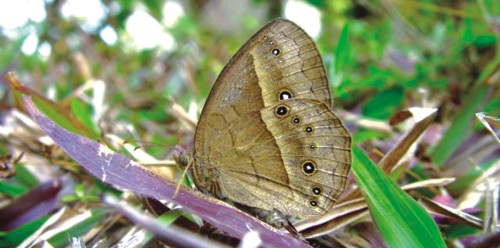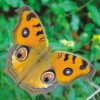| Feature
Study on butterflies at Jahangirnagar University
Emran Hossain

Come to the wonderful world of butterflies at the Jahangirnagar University campus. Enjoy how these beautiful insects wander in flocks. With all the colors of the world imprinted on their flapping wings, these beauties wander all over Jahangirnagar University (JU) campus right from the early morning. If you take a walk down the central road stretching from Bishmile to Botanical Garden, you might find several groups of butterflies circling around the top of a sapling while some others might be found roaming alone over the grassy roadside. They will play hide and seek with you like a little kid until you get going your way.
 “I saw three marvelous looking butterflies on my way to class yesterday morning. Looking at them I felt a surge of joy and emotion and forgot the sorrows I had in my mind early in the morning while leaving the dormitory,” said Tanuza, a student of English. “I saw three marvelous looking butterflies on my way to class yesterday morning. Looking at them I felt a surge of joy and emotion and forgot the sorrows I had in my mind early in the morning while leaving the dormitory,” said Tanuza, a student of English.
“We must do everything we can to offer a friendly environment for these beautiful species. The research on butterflies on JU campus should be continued with greater intensity,” she added.
The number of species of butterflies so far spotted on the campus stands at 87, including 36 species spotted afresh a couple of year back. A group of researchers of JU spotted the new species, reportedly raising the total number of the genus in Bangladesh from 126 to 162. Before the research, 51 species of butterflies were spotted on the campus.
The 36 new species were identified when M A Razzak, a student of Zoology, was conducting a research on butterflies of the campus under the supervision of Asst Prof Monwar Hossain of Zoology in 2003.
 The newly identified short shaped marvelous species are of six families. They are Common Sergeant (Athyma perius Linn), and Commander (Moduza procris Cramer) of Nymphalidae; Wanderer (Pareronia anais Lesson), Indian Cabbage White (Artogeia canidia indica Evans), and Eurema andersonii Moore of Pieridae families. Pea Blue (Lampides boeticus Linn), Angled Pierrot (Caleta caleta decidia), Indian red Flash (Rapla iarbus), Common quicker (Neopithecops zalmora zalmora), Black Spotted (Tarucus balkanicus Bethune-Baker), Forget-me-not (Catochrysops Strabo), Tiny grass Blue (Zizula hylax fab), Club Silverline (Seindasis syama Moore), Plains Cupid (Chilades pandava Horsfield), Common Cerulean (Jamides celeno Cramer), Dark Cerulean (Jamides bochus Stoll), Ape Fly (Spalgis epius Epius), Arhopala pseudocentauruas Doubleday, Curetis saronis indosinica Frushtorfer and Miletus nymphis fictus Corber of Lyeaenidae family. Common Snow Flat (Tagiades japetus ravi Moore), Tree Flitter (Hyarotis adarastus Moore), Oriens sp.Evans, Parnara ganga Evans, Parnara guttata apostate Snellen, Chestnut bob (Iambrix salsala salsala Moore), Polytremis lubricans Herric-Schaffer, Matapa druna Moore, Matapa Sasivarna Moore, Grass Demon (Udaspes Folus Cramer), Gangara thyrsis thyrsis Fab, Peiopidas mathias mathias Fab, Pelopidas agna agna Moore and Indian palm Bob (Saustrus gremius gremius Fab) of Hesperiidae family. Plum Judy (Abisara echerius paionea de Niceville) of Riodinidae and Common Duffer (Discophora sondaica zal Westwood) of Amathusiidae families. The newly identified short shaped marvelous species are of six families. They are Common Sergeant (Athyma perius Linn), and Commander (Moduza procris Cramer) of Nymphalidae; Wanderer (Pareronia anais Lesson), Indian Cabbage White (Artogeia canidia indica Evans), and Eurema andersonii Moore of Pieridae families. Pea Blue (Lampides boeticus Linn), Angled Pierrot (Caleta caleta decidia), Indian red Flash (Rapla iarbus), Common quicker (Neopithecops zalmora zalmora), Black Spotted (Tarucus balkanicus Bethune-Baker), Forget-me-not (Catochrysops Strabo), Tiny grass Blue (Zizula hylax fab), Club Silverline (Seindasis syama Moore), Plains Cupid (Chilades pandava Horsfield), Common Cerulean (Jamides celeno Cramer), Dark Cerulean (Jamides bochus Stoll), Ape Fly (Spalgis epius Epius), Arhopala pseudocentauruas Doubleday, Curetis saronis indosinica Frushtorfer and Miletus nymphis fictus Corber of Lyeaenidae family. Common Snow Flat (Tagiades japetus ravi Moore), Tree Flitter (Hyarotis adarastus Moore), Oriens sp.Evans, Parnara ganga Evans, Parnara guttata apostate Snellen, Chestnut bob (Iambrix salsala salsala Moore), Polytremis lubricans Herric-Schaffer, Matapa druna Moore, Matapa Sasivarna Moore, Grass Demon (Udaspes Folus Cramer), Gangara thyrsis thyrsis Fab, Peiopidas mathias mathias Fab, Pelopidas agna agna Moore and Indian palm Bob (Saustrus gremius gremius Fab) of Hesperiidae family. Plum Judy (Abisara echerius paionea de Niceville) of Riodinidae and Common Duffer (Discophora sondaica zal Westwood) of Amathusiidae families.
The JU Botanical garden, Swimming pool, Bishmile, the different hall gardens, nurseries and the forest behind the administrative building are the places the butterflies inhabit.
At the touch of the first ray of Sun the ultra-violate ray sensible butterflies wake up and wander around until the sun burns hot. The time between rainy and winter season is the spring time when they most prefer to breed, although Butterflies can breed throughout the year. The short-lived butterflies normally survive 20/25 days and like to live on grass and to hang from beneath the leaves.
 Due to their ultra-violate ray sensibility the butterflies can collect food in scanty light, usually from the very early morning to before noon and then again some hours before dusk. They usually rest when the sun burns hotly at noon. Green leaves of different trees including lime, pine, grass and aloe are preferable food to a Larva, young Butterfly, while honey of various flowers and leaves of Rangan are popular with grown-up one. Due to their ultra-violate ray sensibility the butterflies can collect food in scanty light, usually from the very early morning to before noon and then again some hours before dusk. They usually rest when the sun burns hotly at noon. Green leaves of different trees including lime, pine, grass and aloe are preferable food to a Larva, young Butterfly, while honey of various flowers and leaves of Rangan are popular with grown-up one.
“It feels nice walking along the road where you can see huge gatherings of the little species here and there across the campus.
Sometimes it goes beyond my capability to express myself in words when I see some rare butterflies of different color and combinations just flapping before my eyes” said Rahat, a student of Zoology department.
Earlier, in 1996 in a survey Dr Ismail Hossain, Dr Shafiq Haider Chowdhury and Asst Prof Monwar Hossain identified 51 species on the campus.
“Unusual noise by visitors, or by the shooting units of drama and film, plantation of different foreign species of tree and deforestation are hampering their normal activities on the campus premises,” said M A Razzak.
“Fire set by the bush cleaners and estate office employees to clear areas on both sides of different campus-roads also contributes to reducing the species as it harms the normal atmosphere,” he added.
 “Though approximately 500/600 species of butterflies are supposed to be identified in our country within the period since first work on Butterfly, we only identified 126 species excluding the newly identified 36,” said Asst Prof Hossain, adding, “government should introduce a regular monitoring system to make and maintain a list as they are being used in genetic study nowadays and the developed countries have been earning 20/30 million dollar each year through various uses of the butterfly.” “Though approximately 500/600 species of butterflies are supposed to be identified in our country within the period since first work on Butterfly, we only identified 126 species excluding the newly identified 36,” said Asst Prof Hossain, adding, “government should introduce a regular monitoring system to make and maintain a list as they are being used in genetic study nowadays and the developed countries have been earning 20/30 million dollar each year through various uses of the butterfly.”
Dr Mahmudul Amin of Dhaka University (DU) and Dr Shafiq Haider Chowdhury of Chittagong University (CU) started working on butterfly for the first time in Bangladesh in 1968 and identified 27 species. Another 33 species were identified in 1983-85 in a research by M.A. Wahid Box Chowdhury while the Forest Research Institute funded another research, by M S Alam and G M Ullah of CU, who identified 21 species in and around CU in 1987. A total of 126 species of butterfly excluding the newly identified 36 were identified in our country while India identified 2000 species.
The butterflies are the sign of good biodiversity in an area and the government should take steps to preserve the biodiversity of the country which would help protect the little heavenly creatures.

(Emran Hossain is JU Correspondent of The Daily Star)
Copyright
(R) thedailystar.net 2006
|
